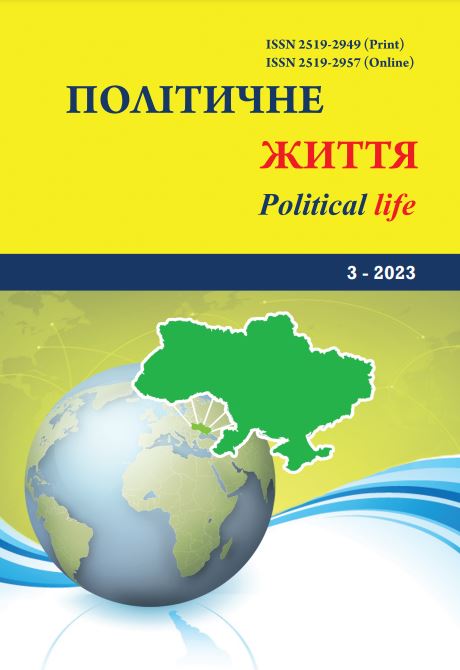Conditions for the formation of borderlands in the historical and political context of the transformation of the world order
DOI:
https://doi.org/10.31558/2519-2949.2023.3.16Keywords:
geopolitical processes; border; borderland; frontier; territories; violenceAbstract
Borderlands, as spaces where two or more spheres of hegemony intersect, seeking to control resources and extend their sphere of influence, are formed in various chronological and spatial contexts with different initial conditions, with historical factors having a key role. This leads to the fact that borderlands are not homogeneous in nature, essence, and forms of interaction with political actors.
The process of borderlands formation is non-linear: the peculiarities of this process depend on spatial and temporal factors. Borders in the same region have different functions and meanings in different periods. Consequently, borders and borderlands in modern Africa, Asia, and Europe also significantly differ.
Before the establishment of nation states, geographical factors contributed to the formation of border areas, which largely determined the initial conditions for these regions: resource potential, access to migration routes, natural preconditions for protection from external aggression, and to some extent, the specifics of political institutions.
In the modern era, Eurasian frontier regions that failed to acquire full-fledged statehood became buffer zones of empires and objects of expansion. At the same time, the empires within which these territories were located tried to consolidate their power by violence. The limited opportunities for expansion on the European continent stimulated the " export" of violence to other parts of the world, where borders and frontiers were formed not on the basis of local specifics, but as a result of decisions made in the empire centers.
The world wars, which largely erupted due to attempts to redistribute borderlands, both in Europe and on the periphery of empires, were the culmination of attempts to establish power over certain regions by force. The outcome of the World War II was attempted to be consolidated by introducing the inviolability of borders as one of the basic principles of international relations. However, in fact, this principle worked only in Europe and North America, while the world hegemons continued to "export" violence to other regions, using them as a battlefield.
In addition, for new and weak sovereignties, "hard borders" proved to be a factor that did not contribute to the development of state institutions. Due to the influence of negative factors, the borders of these countries are transforming into conflict spaces, where the level of violence is constantly growing. In some cases, these conflicts are already destabilizing the states as a whole.
At the same time, under the pressure of globalization, borders around the world are losing their importance and are eroding. Cross-border cooperation and free movement of capital are intensifying, and political power is gradually "migrating" from the state to supranational and subnational actors.
In such circumstances, borderlands can claim their own subjectivity. Depending on the history of their formation and current state, border areas can be transformed into zones of international conflicts, creating threats to international security, or into spaces of intercultural dialogue, contributing to the stabilization of the global political system.
References
Анчабадзе Г.З. Вайнахи. Тбилиси, 2001. 97 с.
Бекирова Г. Крымские татары. 1941–1991 (Опыт политической истории). Симферополь : Издательский дом "Тезис"., 2008. 480 с.
Куромія Гіроакі. Свобода і терор у Донбасі: Українсько-російське прикордоння, 1870–1990-і роки /Пер. з англ.: Г. Кьорян, В. Агеєв; – К.: Видавництво Соломії Павличко "Основи", 2002. 510 с.
Що далі відкладаємо реформи, то більше зростає їх ціна. Gazeta.ua. URL: https://gazeta.ua/articles/opinions-journal/_so-dali-vidkladayemo-reformi-to-bilshe-zrostaye-yih-cina/1053159 (Дата звернення: 07.09.2023).
Andreas P. Redrawing the line: borders and security in the twenty-first century. International security. 2003. Vol. 28, no. 2. P. 78–111. DOI: https://doi.org/10.1162/016228803322761973
Atzili B. When good fences make bad neighbors: fixed borders, state weakness, and international conflict. International security. 2007. Vol. 31, no. 3. P. 139–173. DOI: https://doi.org/10.1162/isec.2007.31.3.139
Baud M., Schendel W. V. Toward a comparative history of borderlands. Journal of world history. 1997. Vol. 8, no. 2. P. 211–242. DOI: https://doi.org/10.1353/jwh.2005.0061
Blatter J. K. Debordering the world of states: Toward a multi-level system in europe and a multi-polity system in north america? Insights from border regions. State/Space. Malden, MA, USA, 2003. P. 185–207. DOI: https://doi.org/10.1002/9780470755686.ch11
Borders and conflicts in north and west africa. OECD, 2022. DOI: https://doi.org/10.1787/6da6d21e-en
Goodhand J. The centrality of margins: the political economy of conflict and development in borderlands. Batticaloa, Sri Lanka, 2018. 57 p.
Rieber A. Imperial space. The struggle for the eurasian borderlands. Cambridge. P. 5–78. DOI: https://doi.org/10.1017/cbo9781107337794.002
The Ukrainians. Як історія допомагає нам зрозуміти цю війну? Частина 1| Ярослав Грицак, 2023. YouTube. URL: https://www.youtube.com/watch?v=JTru5-_3LSg (Дата звернення: 07.09.2023).
Tilly C. Coercion, capital, and European states, AD 990-1990. Cambridge, Mass., USA : B. Blackwell, 1990. 269 p.

